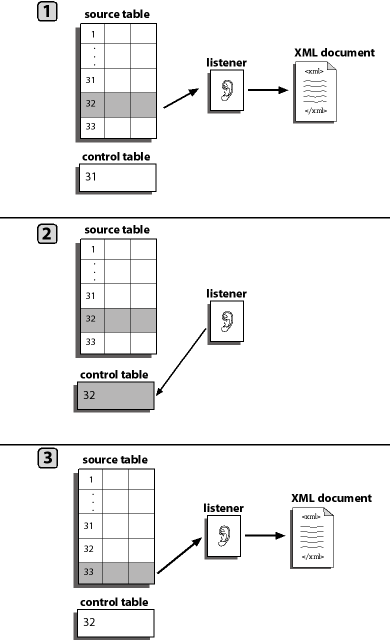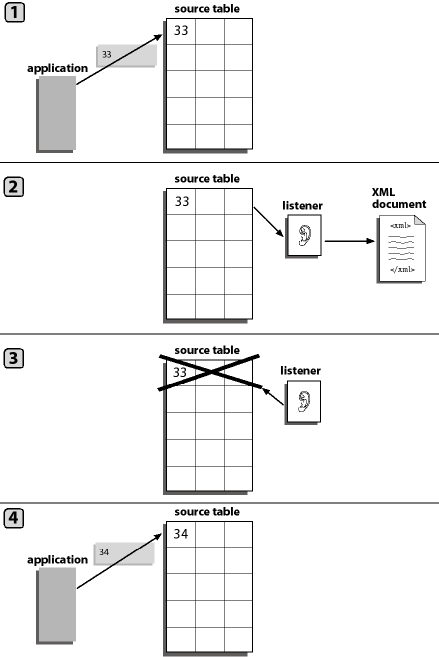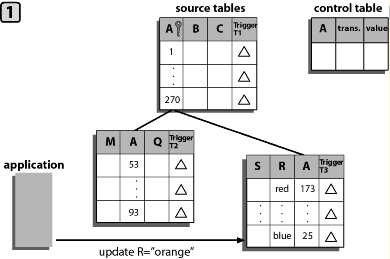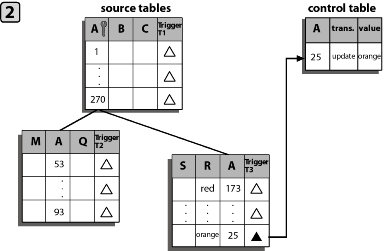Choosing a Listening Technique
You can detect an Oracle E-Business Suite event by using
an RDBMS Table Listener for Oracle E-Business Suite. The Table Listener
polling technology enables you to specify SQL SELECT statements
to execute periodically. After data is polled, it passes through
the event port for additional processing.
You can poll a relational or non-relational database directly
and send the results to a file or JMS message queue. You use the
following techniques to listen to an Oracle E-Business Suite event:
- Standard event
processing with row tracking
The listener polls a table, sends
each newly inserted row to a destination you specify (known as the
disposition), and uses a control table to keep track of the row
that was most recently read. The control table prevents the most
recently read row from being reread during the next listening cycle.
You can apply this flexible yet simple technique in most
situations. For more information, see Standard Event Processing With Row Tracking.
- Standard event
processing with row removal
The listener polls a table, sends
each newly inserted row to a destination you specify, and then deletes
the new row from the table to prevent it from being reread during
the next listening cycle.
You can apply this technique
when the source table is being used to pass data to the adapter,
and the table rows do not need to persist. Rows are deleted as they
are processed. For more information, see Standard Event Processing With Row Removal.
- Trigger-based
event processing
At design time you assign triggers to a joined
group of tables. At run time the triggers write information about
table changes to a common control table. The listener polls the
control table and sends information about the table changes to a
destination you specify. The listener deletes new rows from the
control table to prevent them from being reread during the next
listening cycle.
You can apply this technique when
listening to events in a group of large joined tables, or when you
need to know if a row has been updated or deleted. For more information,
see Trigger-based Event Processing.
Configuration requirement: Copy the JDBC driver
libraries if you have not yet done so to the iway55\lib directory.
x
Standard Event Processing With Row Tracking
The standard event processing with row tracking technique
enables you to listen to the source table without removing its rows.
It requires you to create a single-cell control table that keeps
track of the last new row the RDBMS Table Listener for Oracle E-Business
Suite read from the source table.
The control table's one column corresponds to a column (or to
a group of columns) in the source table that is unique, sortable,
and indicates how recently the row was added to the source table
relative to the other rows. For example, the first row added to
the source table has the lowest value, and the last row added has
the highest value. This value is the "event key."
When you create the control table, initialize it to the event
key of the row most recently added to the source table. When you
specify the listener's properties, configure the listener's Post
Query property to automatically update the control table's event
key.
Each time the listener queries the source table, it looks for
rows added since the last query—that is, for rows whose event key
is greater than the current value of the field in the control table.
It reads each row of this type and returns it to the specified destination
using an XML document. To ensure that the row is not read again
the next time the listener queries the table, the listener updates
the field in the control table to match the value of the row just
read from the source table.
The following figure illustrates standard event processing with
row tracking. It shows the source and control tables, the listener,
and the XML document at various stages.

In the previous figure:
- The Table Listener
queries the source table and copies each source table row whose
event key is greater than the control table's event key. The listener
copies the row to an XML document and sends it to the destination
defined in the port disposition.
- The listener
updates the event key in the control table to match the row it has
most recently read.
- The listener
copies the next source table row to an XML document.
The process repeats.
To implement this event processing technique, see How to Implement Standard Event Processing With Row Tracking.
x
Procedure: How to Implement Standard Event Processing With Row Tracking
To implement standard event processing with row tracking:
-
Create
a control table.
-
Configure
an RDBMS Table Listener for Oracle E-Business Suite using iWay Explorer
or iWay web console.
In addition to the required listener properties,
for standard event processing with row tracking you must also provide
values for the following optional properties:
SQL Query, the SQL SELECT statement
that identifies the source table to which the adapter listens, and
with which it queries the table.
Post
Query, the SQL statements that maintain the field in the control
table.
For instructions for configuring a listener, see Creating a Channel.
For an example of creating the control table,
see the following topic.
Example: Creating the Control Table
for an Oracle E-Business Suite Event
Follow
the steps in this example to create a table named TEMP_NEW_YORK_ORDER_ENTITY
that has a single field named WIP_ENTITY_ID. You specify this table
when you configure the RDBMS Table Listener for Oracle E-Business
Suite, as described in Creating a Channel.
When discrete jobs are created
through the Oracle E-Business Suite graphical interface, an entry
is created in the WIP.WIP_DISCRETE_JOBS table. For this example,
you configure an event to detect new entries to this table. You
use the standard event processing with row tracking technique. (Oracle
E-Business Suite processing cannot delete rows from the table.)
To accomplish this, first create a simple table to track of the
records processed.
- From within
Oracle SQL*PLUS, run the following SQL:
CREATE TABLE WIP.TEMP_NEW_WORK_ORDER_ENTITY_ID
(
WIP_ENTITY_ID NUMBER
)
This creates a single table with
a single field.
Note: Oracle
SQL*Plus is part of the Oracle client software. If it is not installed,
contact your Oracle Database Administrator.
You
must be logged in under the APPS schema or a similar ID that has
access rights to the Oracle E-Business Suite WIP schema.
- Create a single
record in this table and seed it with the highest WIP_ENTITY_ID
ID from your system. You can obtain this from the WIP.WIP_DISCRETE_JOBS
table.
This sets the value at which to start detecting events
as records enter the WIP_DISCRETE_JOBS table.
After you create a simple table in Oracle, you must
configure the Table Listener, as described in Creating a Channel.
x
Standard Event Processing With Row Removal
The standard event processing with row removal technique
assumes that the source table is being used as a conduit to pass
the data to the adapter, and that the table rows do not need to
persist. The RDBMS Table Listener for Oracle E-Business Suite periodically
queries the source table. When it finds a row, it reads it and returns
it to the Reply_to destination via an XML document. To ensure that
the row is not read again when the Table Listener next queries the
table, the listener then deletes the row from the table.
The following figure illustrates standard event processing with
row removal. It shows the application, source table, listener, and
the XML document at various stages in the event processing.

In the previous figure:
- Your application
inserts a new row into the source table.
- The listener
queries the source table and copies the new row to an XML document and
sends it to the destination defined in the port disposition using
the File protocol.
- The listener
deletes the source table row to ensure that the row is not read
again when the listener next queries the table.
- The application
inserts a new row into the source table.
The process repeats itself.
To implement this event processing technique, see How to Implement Standard Event Processing With Row Removal.
x
Procedure: How to Implement Standard Event Processing With Row Removal
To implement the standard event processing with row removal
technique:
-
Configure
an RDBMS Table Listener.
-
In addition
to the required listener properties, provide values for the following
optional properties:
SQL Query, the
SQL SELECT statement that identifies the source table to which the
adapter listens, and with which it queries the table.
Issue Post Query Delete, which
automatically deletes each record after it was read.
For detailed instructions for configuring a listener, see Creating a Channel. For information on SQL post query parameters,
see The Post Query Parameter Operators.
x
Trigger-based Event Processing
Trigger-based event processing is a technique for listening
to multiple joined Oracle E-Business Suite tables. It is also helpful
for detecting when a row was deleted or updated.
The trigger-based technique provides the following benefits:
- Improved performance
when listening to events in a group of large joined tables
When
processing joined tables, Oracle creates a Cartesian product working
table. When the joined tables are large, the interim working table
is very large. The standard technique of processing Oracle E-Business
Suite events, in which the adapter periodically listens to the entire
structure of joined tables, can consume a significant amount of
computing resources.
The trigger-based technique
avoids this overhead by requiring the RDBMS Table Listener for Oracle
E-Business Suite to query a single small control table and by writing to
the control table only when an event actually occurs.
- Increased number
of event types that the adapter recognizes
Using the trigger-based
technique, you can tell when a row was updated, deleted, or inserted.
Using the standard technique, you can tell only when a row was inserted.
To use the trigger-based technique, you assign a trigger to each
table that you want to monitor. When a value changes, it fires the
corresponding trigger, which writes data to a control table. The
iWay Application Adapter for Oracle E-Business Suite listens to
this control table by running a query against it. When it finds
a row in the control table, it reads it and returns it to the port
disposition created when the port is configured via an XML document. To
ensure that the row is not read again when the listener next queries
the table, the listener then deletes the row from the table.
The trigger-based technique enables you to recognize changes
to an entity. For the purposes of this discussion, an entity is
a real-world object that is represented in the database by a hierarchical
set of tables.
You manage the triggers using SQL*Plus or a similar tool and
configure the event using iWay Explorer.
The following five figures illustrate the steps involved in trigger-based
event processing. They show the source and control tables, the listener,
the application, and the XML document at various stages in the event
processing.
- Your application
updates a row in a group of related source tables.

- The update
causes a row trigger to fire in the changed table. The trigger inserts
a row into the control table. The new control table row includes
the key value (25), the type of transaction (update), and the new
cell value (orange).

- The listener
queries the control table and copies the new row to an XML document. It
sends the document to the destination defined in the port disposition.

- The listener
deletes the control table row to ensure that the row is not read
again when the listener next queries the table.

- The application
inserts a new row into one of the source tables.

The process repeats itself.
For a summary of how to implement this technique, see How to Implement Trigger-based Event Processing.
x
Procedure: How to Implement Trigger-based Event Processing
To implement the trigger-based event processing technique:
-
Create
the control table.
The purpose of the control table is to
capture the key of each entity that changed, regardless of which
of the entity tables changed.
You can store
a variety of information in the control table, including the key
of the entity that was inserted, updated, or deleted, and the name
of the table and field that was updated.
The
design of the control table is a function of the business logic
of your application. For example, you can choose between creating
one control table for a group of joined source tables or one control
table per source table. Among the issues to consider are the kinds
of events to monitor (insertions, deletions, and/or updates), and whether
you want to monitor only the highest-level table in a group of joined
tables or all of the tables in the group.
-
Assign
triggers to the source tables.
The triggers you assign, and to which tables
you assign them, is determined by what kind of change you want to
monitor. The triggers implement much of the event-processing logic.
For example, consider a bill of material scenario.
(A bill of materials is a list of all the parts required to manufacture
an item, the subparts required for the parts, and so on. The complete
item/parts/subparts relationship can extend to several levels, creating
a data structure like a tree with the finished item as the root.)
In a bill of materials, where each level in the parts hierarchy
is represented by a separate table, you might assign a trigger to
only the highest-level table (the finished product), or you might
assign triggers to all tables (the finished product and its parts
and subparts).
As another example, if multiple
changes are made to the same row during one listener cycle, you
could configure the event adapter to record all the changes. If
a row was inserted and then updated, both changes would be logged.
-
Configure
the RDBMS Table Listener for Oracle E-Business Suite when creating
a channel using iWay Explorer.
In addition to the required listener properties,
for trigger-based event processing you also must provide values
for the following optional properties:
SQL Query, the SQL SELECT statement that identifies
the control table to which the adapter listens, and with which it
queries the table to determine changes in the source tables.
Post Query, to identify
the rows that the adapter automatically deletes from the control
table.
For detailed instructions for configuring a listener, see Creating a Channel.
Example: Trigger on WIP_ENTITY_NAME
Column
The following trigger fires when a
change is made to the WIP_ENTITY_NAME column of the WIP.WIP_ENTITIES
table. When it fires, it writes the relevant values to the control
table IWAY.IWAY_PO_CDC.
CREATE OR REPLACE TRIGGER IWAY.IWAY_PO_CDC_WE_TRG
AFTER INSERT OR DELETE OR UPDATE OF WIP_ENTITY_NAME
ON WIP.WIP_ENTITIES
FOR EACH ROW
BEGIN
IF INSERTING THEN
INSERT INTO IWAY.IWAY_PO_CDC
VALUES (
:NEW.WIP_ENTITY_ID,
:NEW.ORGANIZATION_ID,
'UPDATE');
ELSE
INSERT INTO IWAY.IWAY_PO_CDC
VALUES (
:OLD.WIP_ENTITY_ID,
:OLD.ORGANIZATION_ID,
'UPDATE');
END IF;
EXCEPTION
WHEN DUP_VAL_ON_INDEX THEN
NULL; -- Record already exists
END;






